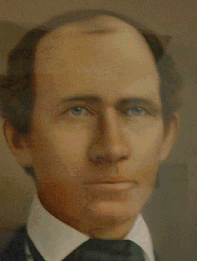William H. H. Ross
| William H.H. Ross | |
|---|---|
 |
|
| 37th Governor of Delaware | |
|
In office January 21, 1851 – January 16, 1855 |
|
| Preceded by | William Tharp |
| Succeeded by | Peter F. Causey |
| Personal details | |
| Born |
June 2, 1814 Laurel, Delaware |
| Died | June 29, 1887 (aged 73) Philadelphia, Pennsylvania |
| Political party | Democratic |
| Spouse(s) | Emeline Hall |
| Residence | Seaford, Delaware |
| Occupation | Farmer |
| Religion | Methodist |
William Henry Harrison Ross (June 2, 1814 – June 29, 1887) was an American farmer and politician from Seaford, in Sussex County, Delaware, United States. He was a member of the Democratic Party who served as Governor of Delaware.
Ross was born in Laurel, Delaware, son of Caleb and Letitia Lofland Ross. He grew up in Laurel, attending the Laurel Academy, and later went to Claremount Academy in Pennsylvania. The Ross family had many business interests, and William added to them by beginning to grow peaches on their property. Like his father, he one day would become a director of the Farmers' Bank of Delaware.
He married Emeline Hall in 1840, and they had ten children, Letitia Lofland, Caleb, George Hall, James Jefferson, William Madison, Edgar Calhoun, Sarah A., Mary G., Laura F., and John Wood. They lived at the Ross Mansion, just north of Seaford, and were members of the Methodist Church.
Ross was a regular delegate to the Democratic National Convention, attending in 1844, 1848, 1856, and 1860. In his only attempt at public office, Ross ran for Governor in 1850, against Thomas Lockwood of Frederica. Lockwood, the Temperance Party candidate, was the main contender, there being no effective Whig candidate. Ross ran with U.S. Representative George R. Riddle and a slogan of "Ross, Riddle and Reform." They were both successful, and Ross served as Governor of Delaware from January 21, 1851, until January 14, 1855. At age 36, he was the youngest person ever elected Governor of Delaware.
In 1852, the long-contemplated building of the north-south Delaware Railroad finally got underway. In the works since the company was chartered in 1836, funds were finally raised and a route laid out. Constitutional reform was also seriously considered at this time. By 1850, New Castle County had nearly half the population of the state, but only one third of the representation in the Delaware General Assembly. This and other populist measures led the Democrats to call for a Constitutional Convention to address them. Using methods that were probably unconstitutional, the Democrats managed to get the Convention convened in December 1852, but the majority of the delegates were Whigs. After several months of negotiation, compromises were reached that satisfied no one and the whole effort was resoundingly rejected at the polls. The Constitution of 1831 would remain in effect.
...
Wikipedia
